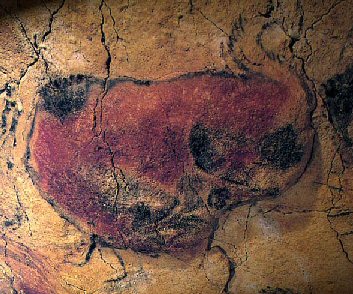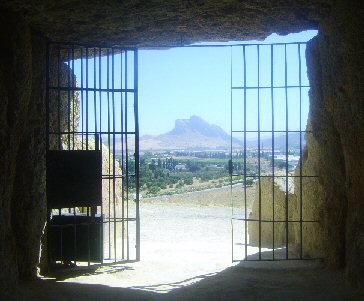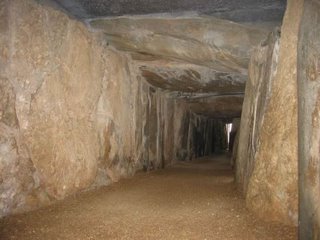|
 Prehistoric Spain:
Prehistoric Spain:
|
Although Spain is not traditionally known for its megaliths, it
nevertheless possesses numerous dolmens, menhirs, cromlechs and other
interesting prehistoric sites.
Quick links:
|
'Traditionally it
was maintained that the Neolithic appeared first in the east and
afterwards in the west. Recent evidence, however, reveals a more complex
pattern. The existence of very early radiocarbon dates of the early
eighth millennium B.P. in several caves of western Andalucia suggests
that there was a nucleus of Neolithic development here which was
independent from that observed in the rest of Iberia (Acosta 1987)',
(1)
Article:
ScienceDaily.com: (June, 2012)
Oldest Rock
Art in Europe Discovered In Spain.
'Recent
studies have shown that the 'Palaeolithic
paintings in El Castillo cave in Northern Spain date back at
least 40,800 years' -- making them Europe's oldest known cave
art, according to new research published June 14 in
Science.
Hand stencils and disks made by blowing paint
onto the wall in El Castillo cave were found to
date back to at least 40,800 years, making them
the oldest known cave art in Europe, 5-10,000
years older than previous examples from France.
A large club-shaped symbol in the famous
polychrome chamber at Altamira was found to be
at least 35,600 years old, indicating that
painting started there 10,000 years earlier than
previously thought, and that the cave was
revisited and painted a number of times over a
period spanning more than 20,000 years'.
(8)
(Link
to Full Aritcle)
|
Featured Spanish Locations: |

Altamira
- Magdalenian Cave-Art.
The Cave art at
Altamira was the first ever discovered in Europe, so early in
fact that unfortunately the discoverer was pilloried for the
rest of his life as a charlatan. Today the artwork is recognised
for its excellence, both in style, colour, and artistic
technical expertise, but also because of the numerous animals
that were painted into the natural 3-dimensional distortions of
the ceiling, something which is only seen less than 20 caves in
all of Europe.
(More
about Altamira)
|
 Cueva
de Menga complex
-
Antequera. Cueva
de Menga complex
-
Antequera.
Cueva de Menga is the largest of three
substantial passage mounds in the area.
It is considered to be one of the largest
such structures in Europe. Running twenty-five metres deep, five metres
wide and four metres high, it was built with thirty-two megaliths, the
largest weighing about 180 tonnes.
The entrance to the dolmen faces the
anthropomorphic Pena de los Enamorados in the distance.
(More
about Cueva da Menga complex)
(Top-50
Megaliths of All Time) |
|
 Los
Milllares
� Neolithic Fortress.
Extensive remains of a megalithic
settlement/fortress were discovered, which include a vast cemetery, dwellings, metal
workshops and several chambered mounds surrounded by stone-circles.
The settlement flourished between 5,100 B.P. and 4,500 B.P. several
'Tholos' similar to those seen in Mycenaean
Greece.
The main site is that of a
Neolithic walled Citadel and passage tomb cemetery, but there are 12
orbital forts and at least two other 'necroplis' on adjoining hilltops.
The site includes several reconstructed parts.
(More about Los Millares) |
|
 Extremadora:
Neolithic complex with over a hundred known
prehistoric sites in a region now divided by the
Spanish/Portuguese border.
A few kilometres away in the C�ceres province of the Extremadura region of Spain 42 dolmen comprise
one of the most important collections in Europe around Valencia de
Alc�ntara. There are believed to be fourteen more whose location is no
longer known. The tourist authority in Valencia de Alc�ntara have set up
megalithic routes Ruta de los D�lmenes.
(Click here for More)
Nearby
and just across the Spanish border is the
Menhir of Meada,
the tallest single standing stone in the Iberian peninsular.
|
|
 'Dolmen'
de Soto
- Andalucia. (Passage mound/Dolmen)
Contains engravings on several of
the orthostats.
It was discovered by Don Armando de
Soto in 1922. Is the more important prehistoric monument of the province
of Huelva.
(More about Soto soon) |
News: Soto
Dolmen Restored to Former Glory...
The photo below is the enormous
structure of the Soto dolmen in Trigueros, Spain, which has been
returned to its prehistoric glory after a nine-year restoration.
The mound is 60 metres across and 3.5 metres high, making it the
largest of more than 200 dolmens, or megalithic tombs, that dot
the Huelva province. The stones that support the Soto dolmen's
interior were originally arranged as a Neolithic stone circle
similar to Stonehenge, before being repurposed in this
structure. When Don Armando de Soto uncovered it in 1922, he
found eight bodies inside, posed in crouching positions near the
wall and surrounded by stone utensils, pottery and decorative
items... More soon.

|
List and Description of Featured Spanish Sites: |
(Prehistoric
Portugal)
|